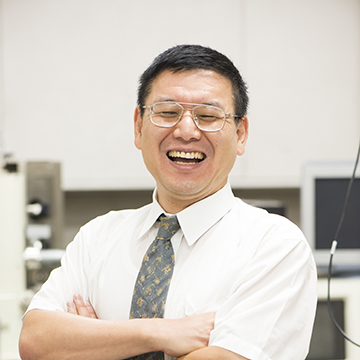
Materials/Devices
Hideki Hosoda
Professor
Physical MetallurgyStructural and Functional MaterialsBiomaterials
Biography
Prof.Hideki Hosoda got Ph.D. at Tokyo Institute of Technology in the field of materials science and engineering. He have worked at Tokyo Tech, University of Washington, NEDO, Tohoku University, Tsukuba University and so on for the material design related to intermetallic compounds and shape memory alloys.
Expectations for WRHI
International collaboration based on new materials we have been developed
Research Projects
-
Research project “Quest for fundamental dynamics of domain homo interface in shape change materials and principles for high performance materials” of Grant-in-Aid for Scientific Research (S), Japan Society for The Promotion of Science is strongly being progressed from FY2014 to 2018.
Topics
-
Research report on Nikkei online
-
Information of Donostia International Workshop on Energy, Materials and Nanotechnology (including Hosoda) is reported in EL DIARIO VASCO (Spain)
| 1993-1996 | Assistant Professor, Dept. Metallurgical Engineering, Tokyo Institute of Technology |
|---|---|
| 1994-1996 | Research Associate, Department of Materials Science and Engineering, University of Washington |
| 1996-1996 | Special Academic Researcher, Ultra-high Temperature Materials Research Institute |
| 1996-1999 | Assistant Professor, Institute for Materials Research, Tohoku University |
| 1999-2001 | Lecturer, Institute of Materials Science, University of Tsukuba, Tsukuba |
| 2001-2010 | Associate Professor, Precision and Intelligence Laboratory, Tokyo Institute of Technology |
| 2010 - 2016 | Professor, Precision and Intelligence Laboratory, Tokyo Institute of Technology |
| 2016- | Professor, Institute of Innovative Research, Tokyo Institute of Technology |
| 1993 | Award for Doctor Thesis, Tejima-Memorial Foundation |
|---|---|
| 1999 | MMS Award, Tanaka Kikinzoku Group (Tokyo, Japan) |
| 2002 | MMS Award, Tanaka Kikinzoku Group (Tokyo, Japan) |
| 2004 | MMS Award, Tanaka Kikinzoku Group (Tokyo, Japan) |
| 2007 | MMS Award, Tanaka Kikinzoku Group (Tokyo, Japan) |
| 2009 | The Japan Institute of Metals and Materials Meritorious Award |
| 2015 | Materia Japan Award for Science and Technology, The Japan Institute of Metals and Materials |
| 2016 | Scripta Materialia Excellence in Reviewing |
| 2016 | Optimum rolling ratio for obtaining {001}<110> recrystallization texture in Ti-Nb-Al biomedical shape memory alloy, T. Inamura, R. Shimizu, H. Y. Kim, S. Miyazaki and H. Hosoda, Materials Science and Engineering C, 61 (2016) 499 |
|---|---|
| 2017 | Formation process of the incompatible martensite microstructure in a beta-titanium shape memory alloy, T. Inamura, M. Ii, M. Tahara and H. Hosoda, Acta Materialia 124 (2017) 351 Effect of Sn and Zr addition on the martensitic transformation behavior of Ti-Mo shape memory alloys, K. Endoh, M. Tahara, T. Inamura and H. Hosoda, Journal of Alloy and Compounds, 695 (2017) 76 Micro-Compression Study of Ni-Fe(Co)-Ga Magnetic Shape Memory Alloy for MEMS Sensors, Kengo Igawa, Tso-Fu Mark Chang, Chun-Yi Chen, Akira Umise, Takashi Nagoshi, Masaki Tahara, Tomonari Inamura, Hideki Hosoda, Volodymyr A. Chernenko, Masato Sone, Proceedings of IEEE SENSORS 2017 (2017) 223-225
|
| 2018 | Large Anhysteretic Deformation of Shape Memory Alloysat Postcritical Temperatures and Stresses, Volodymyr A. Chernenko, Victor A. L’vov, Saurabh Kabra, Ivan R. Aseguinolaza, Manfred Kohl, Hideki Hosoda, Jose M. Barandiaran, Physica Status Solidi B, 225 (2018) 1700273 Vibration damping of Ni-Mn-Ga/silicone composites, J. Feuchtwanger, E. Seif, P. Sratongon, H. Hosoda, V.A.Chernenko, Scripta Materialia, 146 (2018) 9-12 Compression response of Ni–Mn–Ga/silicone composite and study of three dimensional deformation of particles, P. Sratong-on, M. Tahara, T. Inamura, V. A. Chernenko and H. Hosoda, Smart Mater. Struct. 27 (2018) 085024 (10pp) |
